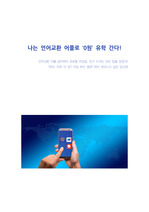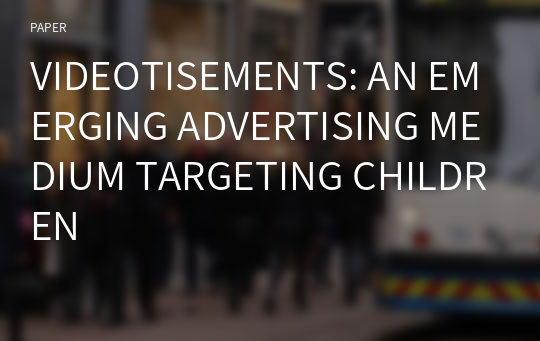VIDEOTISEMENTS: AN EMERGING ADVERTISING MEDIUM TARGETING CHILDREN
* 본 문서는 배포용으로 복사 및 편집이 불가합니다.
서지정보
ㆍ발행기관 : 글로벌지식마케팅경영학회(GFMC)
ㆍ수록지정보 : Global Marketing Conference
ㆍ저자명 : Claire Lambert, Alvin Lee
ㆍ저자명 : Claire Lambert, Alvin Lee
영어 초록
IntroductionAdvertorials promote products by appealing-to and entertaining audiences. These ads increasingly target children aged 5 and younger, a segment of growing importance due to their influence on family buying decisions (McNeal, 1999). A new type of advertorial can be described as video advertisements (videotisements) and currently appear in online channels like YouTube that receive little regulation. They feature products like the Minecraft game or Barbie doll as the main story-line element, with many being viewed tens of millions of times. Videotisement hosts may produce thousands of episodes that feature the same game/doll, forming miniseries encouraging children to return and watch. Videotisements differ from “online influencers”, they exclusively promote one product over a long period (years) and use storylines to demonstrate product use. Advertisers have long promoted products through entertainment shows. This format has been stable for a long time, only recently morphing into videotisements. In the 1950s, TV shows like The Mickey Mouse Club carried embedded persuasive messages (Palmer & Carpenter, 2006). In the 60s, children’s TV featured products like toys. By the 70s, companies were conducting research into ways to attract children, trying to convert their interest into sales. This led the FTC to suggest, in 1978, banning children’s advertising. This proposal accelerated academic research into how children processed TV programs and ads (Ward, Wackman, & Wartella, 1977). These studies investigated covert product placements in shows or movies, lyrics, books (Gupta & Gould, 1997) and online media (Balasubramanian, Karrh & Patwardhan, 2006). Product placements could increase sales, overcome consumer ad resistance and media-fragmentation (Palmer & Carpenter, 2006). This prompted studies of attitudesto (Gupta & Gould, 1997) and effectiveness-of placements (Russell, 2002). There were also unsuccessful calls to ban or disclose placements. The early 2000s saw child-targeted ads flowing to the internet; young children were consuming more web-entertainment and less TV, 80% of children below age 5 used the internet at least once a week (Gutnick, Robb, Takeuchi, & Kotler, 2011) to play games online (Marsh, 2010). The web enabled advertisers to interact directly with children by providing ads that masqueraded as games (advergames), containing commercial logos, mascots and trade characters (Mallinckrodt & Mizerski, 2007). Advergames quickly became among the top five ways to reach children (Vanwesenbeeck, Walrave, & Ponnet, 2017). Some advertisers also started “online communities where children can meet and interact with new and existing friends and play games” (Rozendaal, Slot, van Reijmersdal, & Buijzen, 2013, p.142). Some advergames are distributed through social media like Facebook (Terlutter & Capella, 2013) and its “stealthy nature” (Hudders, Cauberghe, & Panic, 2016) has attracted ethical and regulatory attention (Swanepoel, Lye, & Rugimbana, 2009). The advergame market is now cluttered and advertisers have moved to videotisements. We know very little about this format, this is the impetus for our preliminary study about how children use videotisements. These findings will lead to a more comprehensive study. A videotisement is typically posted on YouTube, Youku and Tudou. The entire video is a covert ad. A host narrates entertaining product information, as the product is used/played with. This is attractive to young children because the videotisement mimics watching other children play – just like watching their friends play games. The clips look professionally produced, suggesting some are linked to product manufacturers (see www.youtube.com/watch?v=w7FX_EnrW1k). A comparative format is the TV infomercial. However, infomercials declare as advertising that sells products – you can order by calling the advertised phone number – videotisements do not do this. Videotisements are produced as video-series. The episodes explore different areas or versions of a game/toy and build on earlier episodes, encouraging children to revisit to follow the story. In some cases, the host becomes a celebrity. For example, Grace Mulgrew who hosts the Grace’s World YouTube channel has over 1 billion views from more than a million subscribers (Stewart, 2018). The episodes show Grace (an “ordinary” 12-year-old) playing with her Barbie dolls. As the storylines develop, Grace displays the latest Barbie characters and accessories. Barbie provides Grace with free dolls and YouTube works with Grace to produce kid-friendly content and educational clips (House, 2015). However, Grace’s World hides these ties. She continues to create, post and promote Barbie videos. Stealthy videotisements are now common; YouTube hosts 56 million videotisements for the Minecraft game. Most of these ads are watched hundreds of thousands of times within the first week, and millions of times by the second week after release. Videotisements also contain commercials and web advertising and children are encouraged to provide personal contact information for membership, competitions or free gifts. So far, this format has not received any attention from researchers. We seem to be the first to study this media and explore children’s exposure-to and preference-for videotisements. Observation of the authors’ children suggest that there is brand preference, the children only watch videos featuring certain games with certain hosts.
Socialisation to Videotisements
Video sharing sites like YouTube are among the first that children below age nine visit (Holloway, Green, & Livingstone, 2013); two thirds of children watch videos on these sites (Hoh, 2017). On average, children up to age two watch games and videos online for two hours daily (Brown, 2011) and five to fifteen year olds are online for 15 hours each week (Ofcom, 2016). Typically, parents enable young children’s access to the web through their phones and tablets, socialising (Sonck, Nikken, & de Haan, 2013) and guiding (Shin & Li, 2017) them to certain content. The frequency of parental and child internet use is positively correlated (Holloway et al., 2013). Older siblings also socialise younger siblings to media and influence what the younger ones do online (Wartella, O’Keefe & Scantlin, 2000); unsurprisingly children with older siblings start using the internet at a younger age (Teuwen, De Groff, & Zaman, 2012). Consequently, three year olds are knowledgeable about multiplayer networked games like Plants vs. Zombies, Minecraft and Mario long before they attain the dexterity to play the games (Dickey, 2007). One way socialisation occurs is when siblings watch videotisements together, these videos are attractive to younger children who cannot yet play the game – they can participate by watching. This raises our research question: What is the level of young children’s exposure to videotisements?
Methodology
As two to five year olds cannot respond adequately about their videotisement use, we surveyed their parents/carers. Respondents were informed of the study’s purpose, providing written consent in the way approved by the University Research Ethics Team.
[Insert Table 1 about here]
Parents were recruited from early childhood learning centres in Singapore (n = 31), a childcare centre and a convenience sample in Australia (n = 17). They were asked about the number of media devices they had at home (access), the amount of time spent using these devices (use), whether the child observes or plays with other children when using these devices (socialisation). We also asked whether parents and siblings watched videotisements with the child (socialisation). Parents answered only about their youngest child. The children’s mean age was 3.12 (SD = 1.07), there were 19 girls (40%) and 29 boys (60%). Most parents were in full time work (Singapore 90%, Australia 88%) and university qualified (Singapore 66%, Australia 82%). All respondents possessed internet enabled devices in their homes that the child could access (Table 1).
Results
A chi-square analysis showed no significant differences between the Singapore and Australia children’s use of media during weekdays (X2 = 1.357, p>.5) or weekends (X2 = 2.212, p>.5), thus we combined the responses for analysis (n = 48). TV was the most popular media, 88% watched on weekdays and 94% on weekends. Videos and videotisements was ranked second and third, followed by playing video/digital games and playing online (Table 2).
[Insert Table 2 about here]
In our sample, 38% have watched videotisements with others, with 56% of this group watching with parents and 22% with siblings (Table 3), 66% of our sample’s parents watched videotisements with their child. Thirty three percent of the children had older siblings, 21% (n=7) of this group watched videotisements together.
[Insert Table 3 about here]
Conclusion
This article provides one of the first looks at children younger than age five’s use of videotisements. While the sample size was small (n = 48), 100% of the parents surveyed in Singapore and Australia responded that their youngest child watched YouTube or videotisements. This gives a strong indication about the level of videotisement use by young children. Parents and siblings help socialise younger children to these ads. The unregulated and stealthy nature of this ad format calls for more investigation of the format, especially by more vulnerable young child audiences. This paper provides a starting point for research into this emerging ad format. Future research may investigate how videotisements influence children’s buying behaviour and family buying decisions; children’s susceptibility to videotisements; and international patterns of videotisement consumption.
참고 자료
없음"Global Marketing Conference"의 다른 논문
 THE ROLES OF GREEN PACKAGING IN UGLY FOOD PURCHASE INTE..22페이지
THE ROLES OF GREEN PACKAGING IN UGLY FOOD PURCHASE INTE..22페이지 THE IMPACT OF INDUCED AWE ON ETHICAL TOURIST BEHAVIORS5페이지
THE IMPACT OF INDUCED AWE ON ETHICAL TOURIST BEHAVIORS5페이지 A BIBLIOMETRIC ANALYSIS OF SPIRITUAL TOURISM RESEARCH15페이지
A BIBLIOMETRIC ANALYSIS OF SPIRITUAL TOURISM RESEARCH15페이지 SOCIAL NETWORK ANALYSIS AND RESPONSE TIME TESTING: CONS..11페이지
SOCIAL NETWORK ANALYSIS AND RESPONSE TIME TESTING: CONS..11페이지 THE EFFECTS OF PARA-SOCIAL INTERACTION ON ONLINE CELEBR..3페이지
THE EFFECTS OF PARA-SOCIAL INTERACTION ON ONLINE CELEBR..3페이지 THE INFLUENCE OF OPINION LEADERS ON DAILY DEALS USER’S ..3페이지
THE INFLUENCE OF OPINION LEADERS ON DAILY DEALS USER’S ..3페이지 HOW IMMERSIVE RETAILING AFFECTS CONSUMERS’ URGE TO BUY:..6페이지
HOW IMMERSIVE RETAILING AFFECTS CONSUMERS’ URGE TO BUY:..6페이지 KEY TO SUPERSTARDOM IN A GLOBALISED MARKET: THE ROLE OF..6페이지
KEY TO SUPERSTARDOM IN A GLOBALISED MARKET: THE ROLE OF..6페이지 A POST-PANDEMIC LOOK AT TOURISTS’ PERCEIVED COOLNESS OF..4페이지
A POST-PANDEMIC LOOK AT TOURISTS’ PERCEIVED COOLNESS OF..4페이지 EXTRACTING OFFLINE RETAIL SHOPPING PATTERNS: OLLABORATI..5페이지
EXTRACTING OFFLINE RETAIL SHOPPING PATTERNS: OLLABORATI..5페이지


























